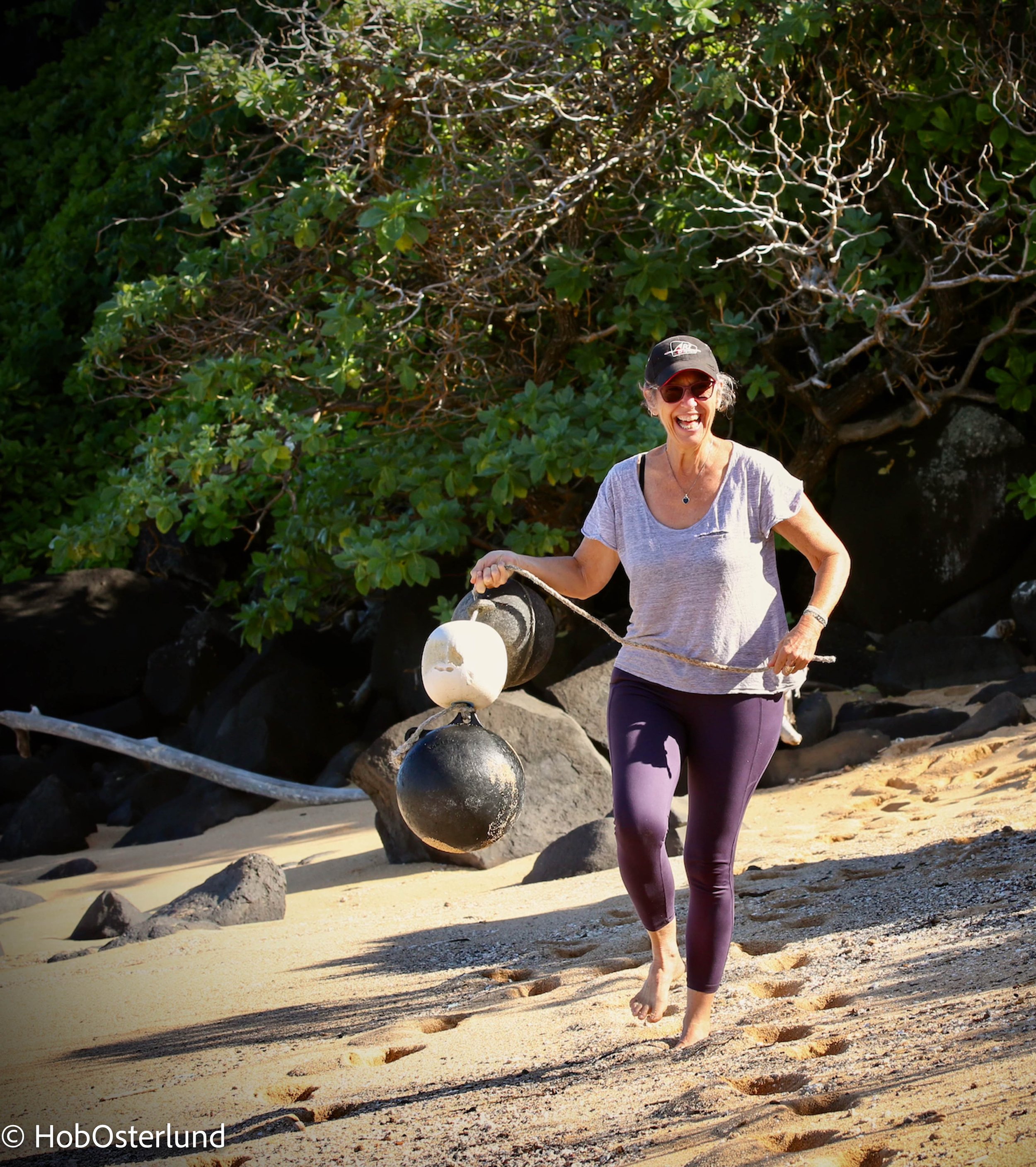From Flotsam to Fine Art
Sharon Rothschild Finds a Talent for Fishing Floats
By Hob Osterlund, Safina Center Senior Fellow | Conservationist in Residence
Sharon Rothschild finds floats on a Kauaʻi beach. Photo by Hob Osterlund
One day in early 2020, multimedia artist Sharon Rothschild was driving down a rural road in the hills of Kaua’i, several miles from her home. Glancing at the roadside shoulder, she happened to notice a dinged-up black plastic fishing float. For no conscious reason, she made a U-turn and picked up the former flotsam. But the closer she considered it, the clearer it got: she could transform the float into art. What if she gave it a try? Plus there would be the added satisfaction of removing rubbish washed up on Kaua’i beaches.
Fast forward twenty months. In that time Sharon has added a whole new talent to her repertoire, joined the voices raised against pelagic plastic and encouraged shoppers to do something about the problem. Her floats are highly varied but might include a caricature of an albatross, a happy octopus, or a predatory shark who lets off a “I would eat you but I’m too busy” vibe. One stunning black-and-white float is covered with a lace design and commemorates Ruth Bader Ginsburg. Others are called Reefer Madness and Fish Taco Tuesday and Dressed to Krill.
Sharon Rothschild and one of her fishing floats. Photo by Hob Osterlund
Hob Osterlund: Congratulations, Sharon, on your recent exhibit with the Kauaʻi Society of Artists. You would think a show like “Washed Up, Marine Debris” might be rather depressing. And yet there was an animated, engaged and enthusiastic crowd. What do you attribute that to?
Sharon Rothschild: This annual show curated by Abigail Burroughs has attracted participants for at least five years. It has enjoyed a loyal following because the community celebrates creative and innovative ways to keep our beaches clean. “Upcycling” trash into art is a fun way to do that.
Sharon Rothschildʻs floats in recent art exhibit. Photo by Hob Osterlund
HO: I notice Surfrider Foundation co-sponsored the exhibit. Tell us more about how your art aligns with their goals.
SR: Surfrider is dedicated to protecting marine life and providing enjoyment for people at the seashore. Getting the plastic off the beach is a priority, so I take great pleasure in helping them in that goal.
HO: Looking back on when you first saw that old float in a ditch, where do you think your inspiration came from?
SR: Working at Ola’s Hanalei for many years, I was inspired by Doug Britt’s paintings and his use of beach debris in his work. Abigail was also on my mind, with how she integrated plastic trash into her books.
HO: Tell us about your process in preparing and painting a float. Do they require a special kind of cleaning after their years at sea? Do you etch the figures ahead of time?
SR: Each float needs to be sanded and washed. Barnacles have to be removed. Once they are clean and dry, I paint a base coat and use acrylics on top of that. New friends and favorite characters make their appearances, entertaining me all the while.
HO: Birds and fish figure prominently on your floats. What do you hope their presence will communicate?
SR: Colorful, shy and sometimes flirtatious, birds touch my heart. The shama sings to me in my studio, and the albatross amaze me on my walks over the shore cliffs. Ideally, the floats bring awareness of the beauty above and below the sea. Fish and floats just go together.
HO: Your work can be hung from ceilings, mounted like sculptures and used as planters. Whatʻs your favorite way to see them displayed?
Sharon Rothschildʻs living room includes her own float, a ship made from recycled copper gutters by Doug Britt and a painting by Evelyn DeBuhr. Photo by Nazira De Marchi
SR: I love fashion, and I incorporate it into my island life—and my island art. My favorite float hangs in my living room, dressed in black tulle. It’s a fashion statement and a fun way to hang a float.
HO: What would you like to see happen next? And to see others do?
SR: I want to incorporate other found objects into my floats along with other practical uses for my floats. As I walk the beach, I search for ideas. I know they will gently drift into my consciousness and appear in my studio. As for others, I would like to see people take a bag to the beach always, pick up any glass or plastic they find and bring it home to turn into art. It’s a good way to engage children and teach the next generation to do a better job than we’ve done keeping plastic out of the ocean.
Friend Joanne Little helps Sharon Rothschild collect floats. Photo by Hob Osterlund
To contact Sharon Rothschild about her floats, email her at sarothschild@yahoo.com. Read more about her work here.
To learn more about pelagic plastics, read hot-off-the-press Thicker Than Water: The Quest for Solutions to the Plastic Crisis by Erica Cirino (Island Press, 2021)





